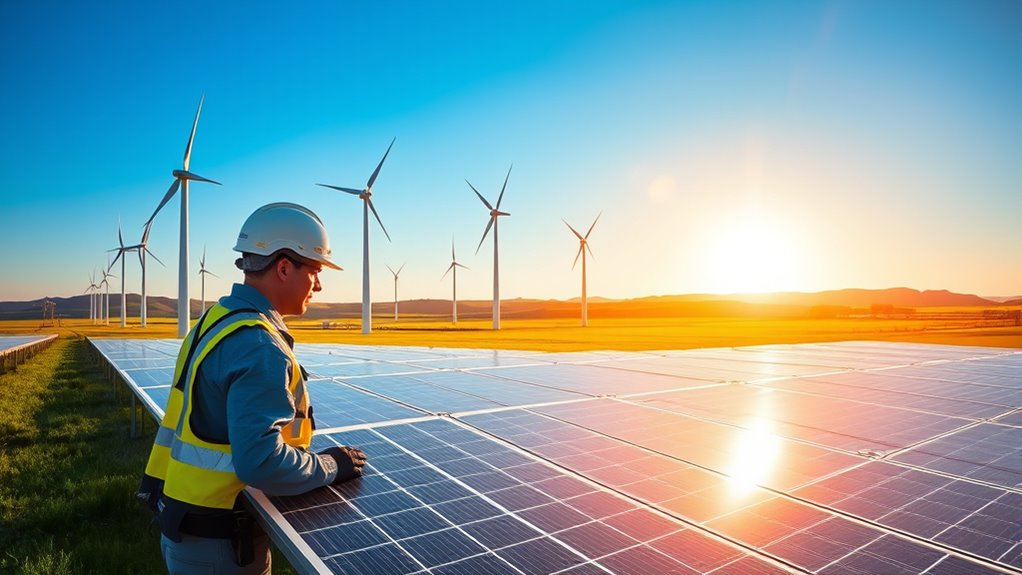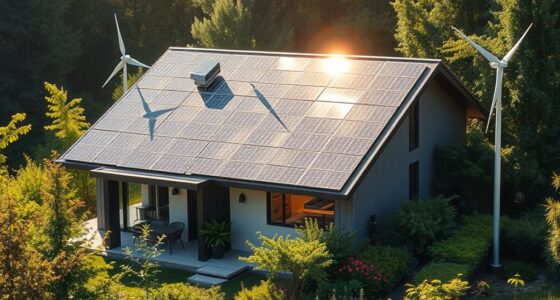Many myths about renewable energy, like solar and wind being unreliable or too costly, are outdated. Advances in technology, energy storage, and smarter grids now make these sources dependable and affordable, even in less sunny or windy areas. Proper siting and innovations reduce wildlife and visual concerns. If you want to understand how these technologies overcome past misconceptions and support a sustainable future, there’s more to discover.
Key Takeaways
- Advances in storage and grid management have made solar energy reliable even during night and cloudy days.
- Wind turbines are generally quieter than household appliances and have minimal impact on wildlife with proper siting.
- Technological innovations enable renewables to meet large-scale energy demands, making them integral to the future grid.
- Myths about renewable energy’s inefficiency are outdated; modern solutions support consistent, substantial power generation.
- Understanding and addressing misconceptions accelerates renewable infrastructure development and promotes a sustainable energy transition.

Are misconceptions about renewable energy hindering progress toward a sustainable future? Many people still believe that renewable sources like solar and wind aren’t reliable or practical, but the truth is quite different. One common myth revolves around solar viability. Critics often argue that solar power isn’t dependable because sunlight isn’t available at night or during cloudy days. However, advances in energy storage and grid management have dramatically improved solar’s reliability. Modern solar systems can store excess energy for use when the sun isn’t shining, making solar power a consistent and feasible option for many regions. Additionally, cost reduction of solar panels has plummeted over the past decade, making solar energy more affordable and accessible than ever before. This means that solar power can now contribute considerably to the energy mix, even in less sunny areas. Furthermore, state tax implications can influence the economic viability of solar investments, highlighting the importance of understanding local policies. The ongoing development of renewable energy infrastructure supports this shift toward more sustainable energy solutions. Enhanced grid integration and technological innovations have further strengthened the reliability of renewable sources, ensuring they can meet increasing energy demands. The wind impact on the environment is also positive, as wind energy produces no greenhouse gases during operation, helping combat climate change. Moreover, AI-driven forecasting plays a crucial role in optimizing renewable energy output and managing grid stability effectively.
Another misconception centers around wind impact. People often claim that wind turbines are noisy, harmful to wildlife, or visually unappealing, and consequently shouldn’t be part of our energy future. While it’s true that wind turbines can produce some noise, the levels are generally comparable to everyday household sounds, and modern turbine designs have minimized noise pollution. Concerns about wildlife impact are valid but can be addressed with proper siting and technological improvements. Many studies show that wind farms tend to have a lower impact on wildlife than some traditional energy sources like coal or natural gas. As for visual concerns, wind turbines are usually placed in areas where they blend into the landscape or are situated offshore, reducing their visual footprint. The wind impact on the environment is also positive, as wind energy produces no greenhouse gases during operation, helping combat climate change.
Many misconceptions also ignore the progress in grid integration and technological innovation. As renewable energy sources become more widespread, smarter grids and better forecasting tools help manage fluctuations and balance supply and demand. This means that renewable energy isn’t just a niche solution; it’s becoming a dependable component of our overall energy system. The myth that renewables can’t meet large-scale demands is simply outdated. With ongoing advancements, renewables like solar and wind are not only feasible but essential for building a sustainable, resilient energy future. So, rather than dismissing these clean sources based on myths, it’s crucial to recognize the strides made in solar viability and wind impact, which are shaping a cleaner, more sustainable world.
Frequently Asked Questions
How Does Renewable Energy Impact Local Wildlife Habitats?
Renewable energy projects can impact local wildlife habitats by causing wildlife disturbance and habitat fragmentation. You might notice construction activities disrupting animal behaviors or splitting ecosystems apart. However, careful planning and environmental assessments help minimize these effects, allowing renewable energy to coexist more sustainably with wildlife. By understanding and addressing these concerns, you can support clean energy solutions that protect ecosystems while reducing reliance on fossil fuels.
Can Renewable Energy Fully Replace Fossil Fuels Globally?
Imagine a vast, glowing tree representing global energy needs. You might wonder if renewable energy can fully replace fossil fuels. While advancements in energy storage and grid integration help, complete replacement remains challenging due to intermittency and infrastructure limits. You’ll need ongoing innovation and investment to make renewables more reliable, but it’s a promising path toward a cleaner future. Full shift is possible, but it requires time and effort.
What Are the Health Risks Associated With Renewable Energy Technologies?
You might worry about health concerns linked to renewable energy technologies, but they’re generally safe. Solar panels and wind turbines pose minimal risks, mainly from manufacturing or installation processes, which are well-regulated. Unlike fossil fuels, renewable tech doesn’t emit harmful pollutants that affect your health. Overall, the technology safety of renewables makes them a cleaner, safer alternative, reducing health risks associated with air and water pollution from traditional energy sources.
How Do Renewable Energy Costs Compare to Traditional Energy Over Time?
When you look at the cost trend analysis, renewable energy has become more economically competitive over time. Initially, it was expensive, but technological advancements and scaling have driven costs down markedly. Today, renewables often match or beat traditional energy prices, especially with incentives. This improved economic competitiveness means you’ll likely save money in the long run, making renewable energy a smart, sustainable choice for your energy needs.
Are Renewable Energy Sources Reliable During Extreme Weather Events?
Did you know that some renewable energy sources like wind and solar can provide over 80% of their capacity during extreme weather? While weather can impact energy production, advancements in energy storage and grid resilience help guarantee reliable power. By integrating storage solutions and strengthening grids, renewable energy becomes more dependable even during storms or droughts, making it a viable alternative in all weather conditions.
Conclusion
You now see that renewable energy isn’t as unreliable or costly as many believe. In fact, solar and wind power make up over 12% of global electricity, and their costs keep dropping. With advancements and increased investment, renewables are becoming more accessible and efficient. Don’t let myths hold you back—embracing clean energy can help protect our planet and boost the economy. The future of energy is bright, affordable, and sustainable—it’s time to get on board.









